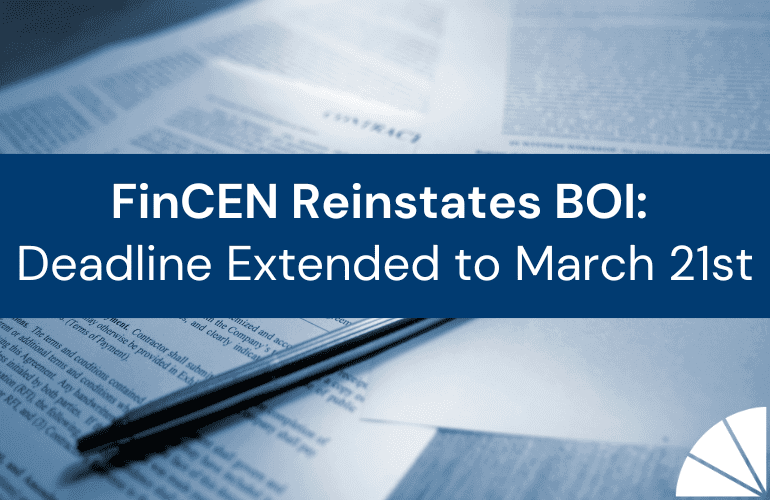Essential Year-End Tax Planning Tips for Closely Held Businesses
As the year-end approaches, closely held businesses have a valuable opportunity to optimize their tax situation. Proactive tax planning doesn’t just reduce your immediate tax burden; it builds a stronger financial foundation for the future.
Preparation vs Planning
It is important to understand the difference between tax preparation and tax planning. Tax preparation is the process of gathering information and filing forms for something that happened in the past. There are very few tax savings opportunities for the year at hand, but it may provide guidance for opportunities in the next tax filing year. Tax planning is forward-looking, the process of reviewing information before year-end and developing strategies to not only implement tax savings opportunities but also prepare you for an estimated tax liability upon the tax preparation to help plan for cash flow in a more timely matter.
Here’s an example of how to maximize tax benefits, improve cash flow, and set your business up for success in the coming year. Consider a family-owned construction company that waits until tax season to review finances. This reactive approach limits the company to confirming deductions and filing forms. By shifting to proactive tax planning, however, they could use strategies year-round—like deferring income, accelerating expenses, and restructuring—to reduce their tax burden. This approach can lead to lower taxes owed and improved cash flow. The company can also know ahead of time what their tax liability will be so they can plan for this future cash flow.
Let’s look at critical aspects of year-end planning to help you move from a reactive to a proactive approach to keep more money in your pocket.
Maximize Tax Credits and Deductions
Don’t leave potential savings on the table—closely held businesses can benefit from various tax credits and deductions.
Employee Benefit Tax Deductions
Consider rewarding yourself or your employees with a year-end payroll bonus or increasing contributions to employee benefits before year-end to boost deductions, such as:
- Retirement Contributions – current plans: Contributions to 401(k)s and similar plans are deductible and may not need to be fully funded until the following tax year.
- Retirement Contributions – new plans: Setting up a new retirement plan can offer tax credits.
- Health Savings Accounts (HSAs): HSAs offer a triple tax advantage for the employer and employee if you qualify.
- Fringe Benefits: Benefits like some life insurance policies, travel expenses, and educational assistance can reduce your taxable income.
Key Tax Credits or Deductions
Some of the most valuable tax credits or tax deductions for small businesses include:
- Research and Development (R&D) Credit: Ideal for businesses investing in product or process innovation.
- Work Opportunity Tax Credit (WOTC): Provides credits for hiring employees from targeted groups.
- Energy-Efficient Investment Credits: Tax incentives for energy-saving business investments.
- Qualified Business Income (QBI) Deduction: A deduction of up to 20% for qualifying pass-through businesses.
- Pass–Through Entity Tax (PTET): A deduction allowed for passthrough entities to help offset the owner’s state income tax.
Download Our “34 Big Tax Deductions for Businesses in 2024” Infographic: Don’t miss out on additional valuable deductions!
Plan Estimated Tax Payments Carefully
Avoid costly penalties by carefully managing estimated tax payments. Here’s how to stay compliant and maintain cash flow:
- Track Income and Expenses Quarterly: Monitoring finances regularly gives you more accurate estimates and allows timely adjustments.
- Use Current Data for Payment Calculations: While last year’s tax liability can be a guide, adjustments may be needed for significant income or expense changes. Our tax professionals can help fine-tune payments.
- Adjust Payments with Business Changes: For profitable quarters, consider increasing your next estimated payment to avoid underpayment penalties.
Take Advantage of Depreciation and Capital Expenditures
Planning capital expenditures before year-end can significantly reduce taxable income. Section 179 expensing and bonus depreciation allow you to deduct the cost of qualifying property and equipment placed in service by year-end—ideal for businesses aiming to grow while maximizing tax savings.
Ensure Year-End Compliance
Maintaining compliance is essential to avoid IRS scrutiny and secure deductions. A year-end tax review with your advisor can help ensure:
- Payroll Accuracy: Verify that payroll taxes and filings are correct.
- Timely Filings: Submit all required tax filings by the appropriate deadlines.
- Accurate Documentation: Keep detailed records for all credits and deductions claimed.
Strategic Planning for a Lower 2025 Tax Burden
Looking ahead to next year? Consider these advanced strategies:
- Income Shifting: Shift income to lower-taxed family members via salaries or dividends.
- Entity Restructuring: Restructure as an S corporation to reduce self-employment taxes.
- Estate Planning: Minimize tax exposure on wealth transfers through gifting or trust setups.
More Opportunities for Savings
For additional tax-saving ideas, review our 2024-25 annual tax planning guide for businesses and families. With the 2025 Tax Cuts and Jobs Act (TCJA) sunset approaching, proactive planning is more essential than ever.
Simplify Tax Planning with Tax Guidance From an Advisor
At LGA, our tax advisors help businesses and individuals develop tax strategies tailored to their financial goals. Let us simplify tax planning so you can focus on growing your business. Schedule a tax-planning session with us today to maximize your tax savings!






